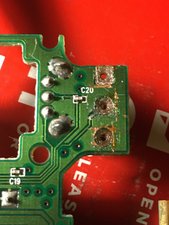Fixing destroyed solder pads
Hello I attempted for the first time to desolder and attach some new switches. Things did not go well… I thought a fix would be to follow this guide: https://www.instructables.com/How-to-Rep...
Upon completion there was still no contact with both M1&M2; here are the photos after I cleaned up.


In the first photo as you can see I attempted to cut the excess copper before solder, not sure which method would have worked better considering the copper adhesive would move even after being heated which was expected.
My primary questions I suppose would be in photo 1 am I suppose to match the adhesive exactly to size or can I have some excess laying on the PCB? Am I also to clean more thoroughly? I used 97% isopropyl with electronic swabs. The soldering wire has flux so I didn’t apply any flux paste which came with my kit.
In photo 2 am In trouble with the trace? I should also ask if my method would even work using 5mm copper adhesive.
P.S. I can make an additional thread for this but I tried the same method as well on my Celeritas keyboard

and had no function with the switch I used?
What’s the deal? Thanks for reading and any help!


 11
11  366
366  1.4千
1.4千 